Ever wonder how to make hard kombucha (i.e. kombucha with more alcohol in it)? We’re breaking down the basics to alcoholic kombucha. It’s easier than you would think!
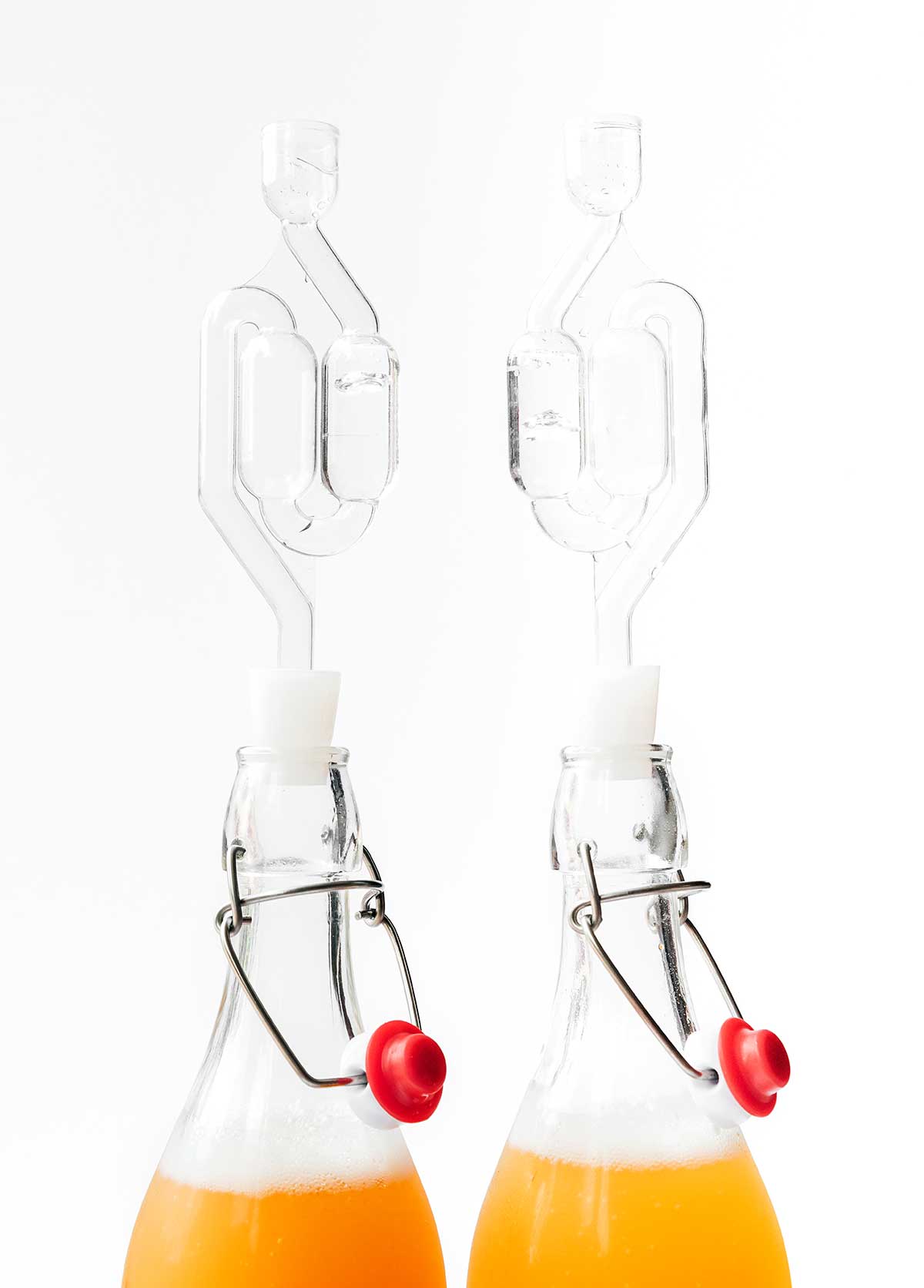
The basics of hard kombucha
Kombucha naturally contains some alcohol (about 0.5%). This is due to the reaction between the naturally occurring yeast in the kombucha, which produces trace amounts of ethanol (alcohol).
Typical kombucha yeast strains do not produce much alcohol on their own, so what do you do if you want to increase the amount of alcohol in your kombucha? Add a different kind of yeast!
By adding a different strain of yeast, such as champagne yeast, to your kombucha, you can make a hard kombucha beverage with a higher ABV (alcohol by volume), around 5%!
After much experimentation (and years of brewing non-alcoholic kombucha to help guide me), I’ve finally landed on the method of brewing hard kombucha that’s both easy and reliable. Let’s brew!
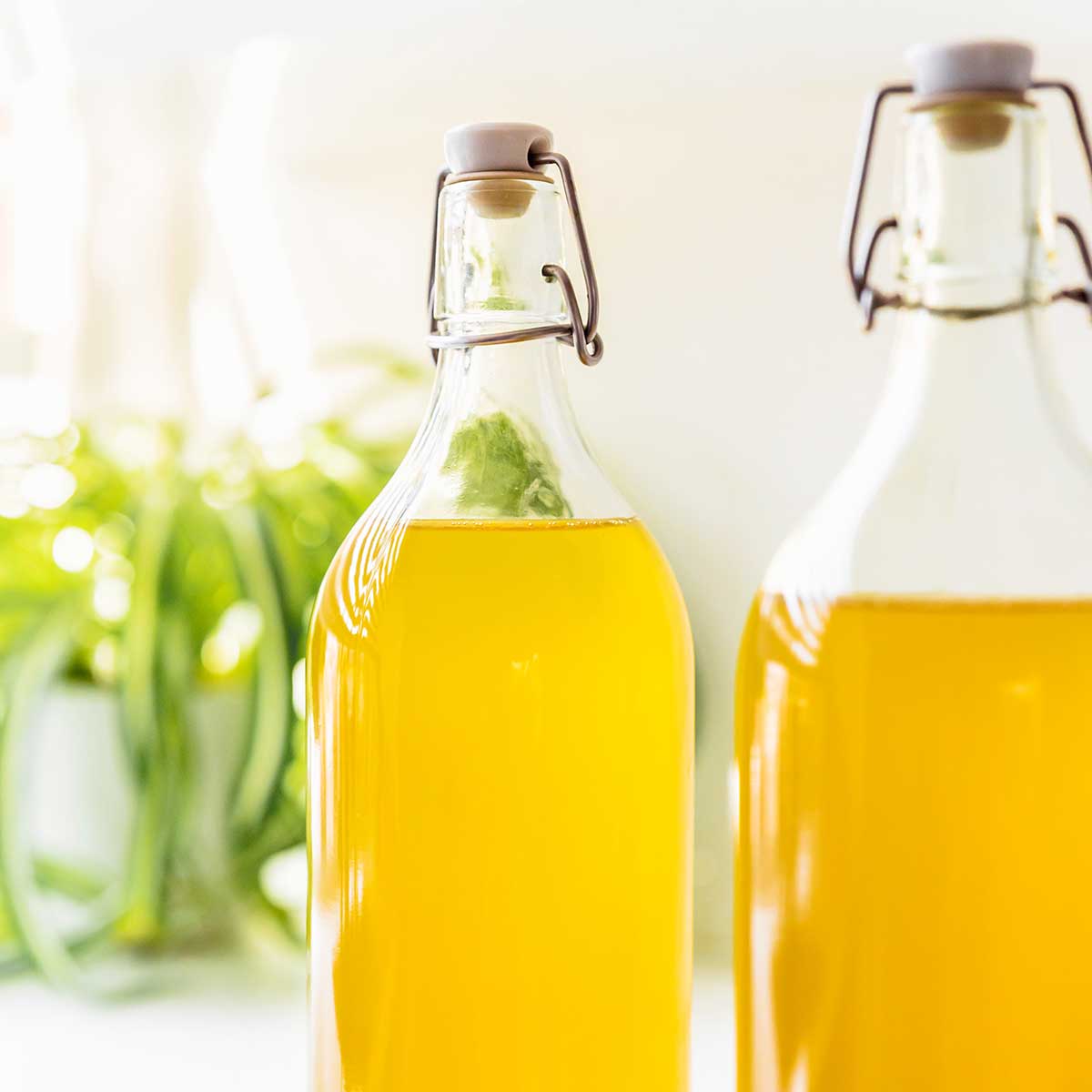
Main Ingredients & Supplies needed for alcoholic kombucha
Kombucha from a first fermentation
First up, you’ll need some kombucha! Take your batch of kombucha straight from the first fermentation to make hard buch. (Here’s how to make kombucha in the first fermentation.) You can use kombucha made from green or black tea here.
Yeast
Adding an additional strain of yeast (different from the kombucha yeast) will help drive up the alcohol content of your kombucha. The type of yeast you choose to use will impact the finished flavor. Some options include:
- Champagne yeast (like this EC-1118 dry wine yeast), which gives a distinctly champagne flavor to your hard kombucha
- Ale yeast (like this SafAle US-05), which has a more neutral flavor
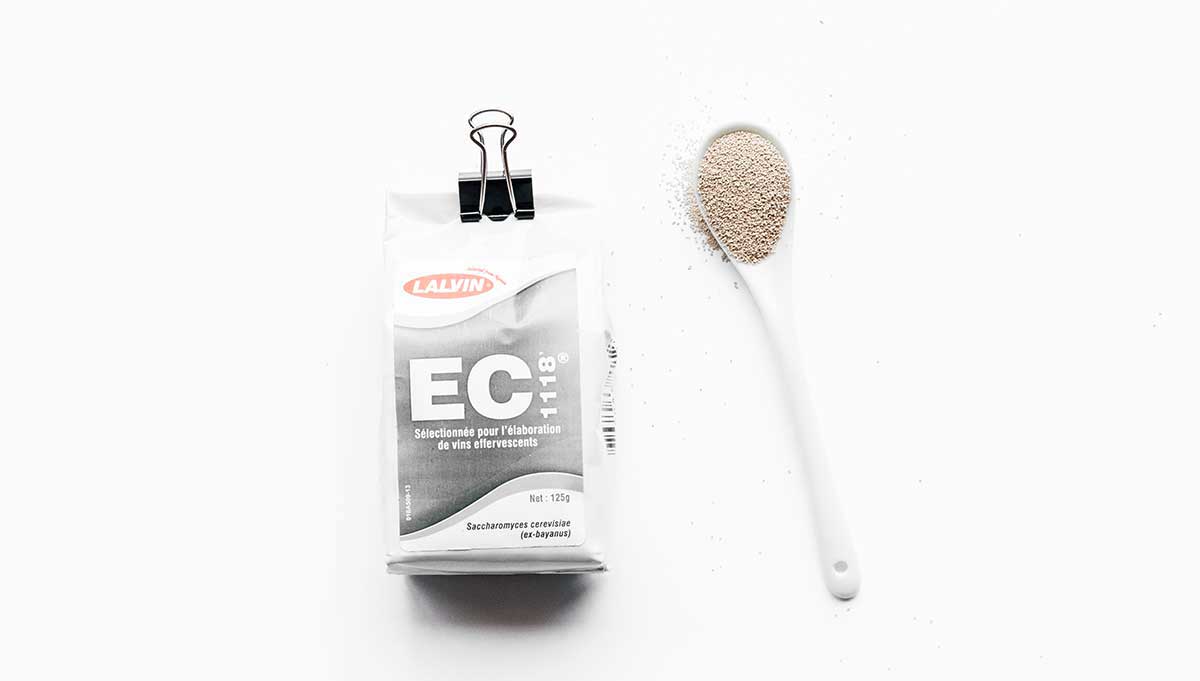
Airlock
The final extra piece of gear you’ll need to brew hard kombucha are airlocks. These effectively let carbonation escape without letting oxygen in.
“But doesn’t kombucha need oxygen?” Good question! When making kombucha in the first fermentation, the bacteria need oxygen to ferment properly. But once the kombucha is finished and you’re ready to booze it up, you’ll want to prevent oxygen from getting to the bacteria so that the bacteria don’t eat the alcohol you’re making! (More on the relationship between bacteria and alcohol in kombucha here.)
A lid won’t work here because you need to allow for air to leave the bottle!
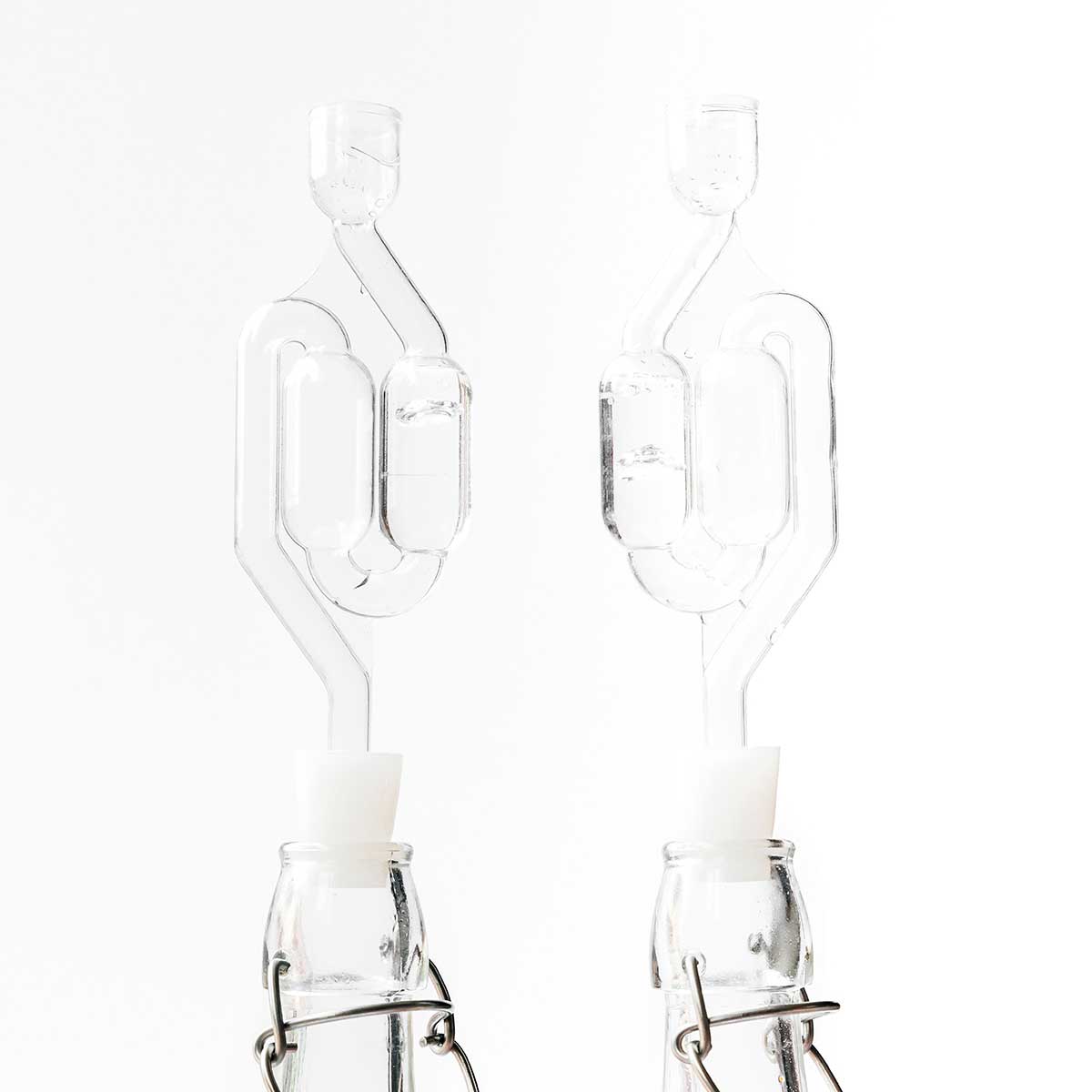
How to make hard kombucha
The process of making hard kombucha is a little different from making traditional kombucha in that we’re adding an extra step in the middle. It goes something like this!
- 1st Fermentation: Make the kombucha (6 to 10 days). This is when you turn sweet tea into kombucha!
- 2nd Fermentation: Make it boozy by adding yeast and sugar, then let alcohol develop (7 to 14 days)
- 3rd Fermentation (optional): Add flavors and seal shut to carbonate (3 to 10 days)
Easy enough, right? Let’s dig into the details!
1st Fermentation: Make the kombucha
In the first step, you’re making kombucha just as usual. You’ll just put sweetened tea, starter kombucha, and a SCOBY (symbiotic culture of bacteria and yeast) into a large jar and let it ferment for 6 to 10 days until you reach your desired flavor (a mix of sweet and tart). Get instructions for the first fermentation here.
2nd Fermentation: Make it Boozy
In the second step, we’ll add a slurry of yeast, sugar, and water, which will increase the alcohol content of your brew. You’ll need:
- 1 cup hot water
- 1 cup white sugar
- 1 tsp yeast (champagne or ale yeast, see notes above)
- 1 gallon of kombucha (from first fermentation)
- Airlocks
1. Yeast Slurry: Stir together the hot water and sugar until sugar is dissolved. Let it cool to lukewarm, then stir in yeast. Allow the yeast to activate for 5 minutes, until bubbles form and the yeast is frothy.
2. Bottle: Meanwhile, transfer kombucha to bottles or a growler (or any vessel with an opening that will fit your airlocks. Portion yeast slurry equally into each bottle of kombucha.
3. Airlock: Fill airlocks with water (to the designated line – you may need to read the instructions for your particular airlocks). Place airlocks onto each bottle.
4. Ferment: Set bottles somewhere dark and room temperature, and let ferment for 7 to 14 days. It’s ready when the flavor is somewhat dry and boozy! If you’re not moving on to the next step (adding flavor), seal the bottles shut and transfer to the fridge to stop the fermentation process.
“I’ve made it and it’s WONDERFUL!
I was wondering what you needed to do to raise the alcohol content. More Yeast? More sugar?”
3rd FERMENTATION: Add flavor
In this final (and optional) step, you can add flavors to give your hard kombucha a fun taste. This is the equivalent of the “second fermentation” in traditional kombucha brewing. You’ll just add whatever flavors you want to your bottle (like pureed fruit, fruit juice, ginger, herbs, or spices), then seal it shut. Let sit for 3 to 10 days, until bubbly and carbonated. Transfer bottles to the fridge to stop the fermentation process. Check out all of our flavor recipes here!
How much alcohol is in my hard kombucha?
The amount of alcohol in your finished hard kombucha will depend on how much sugar you added in the 2nd fermentation. Typically each 1 cup of sugar will give you about 4% ABV. Increasing this ratio and adding more sugar will result in a higher alcohol level.
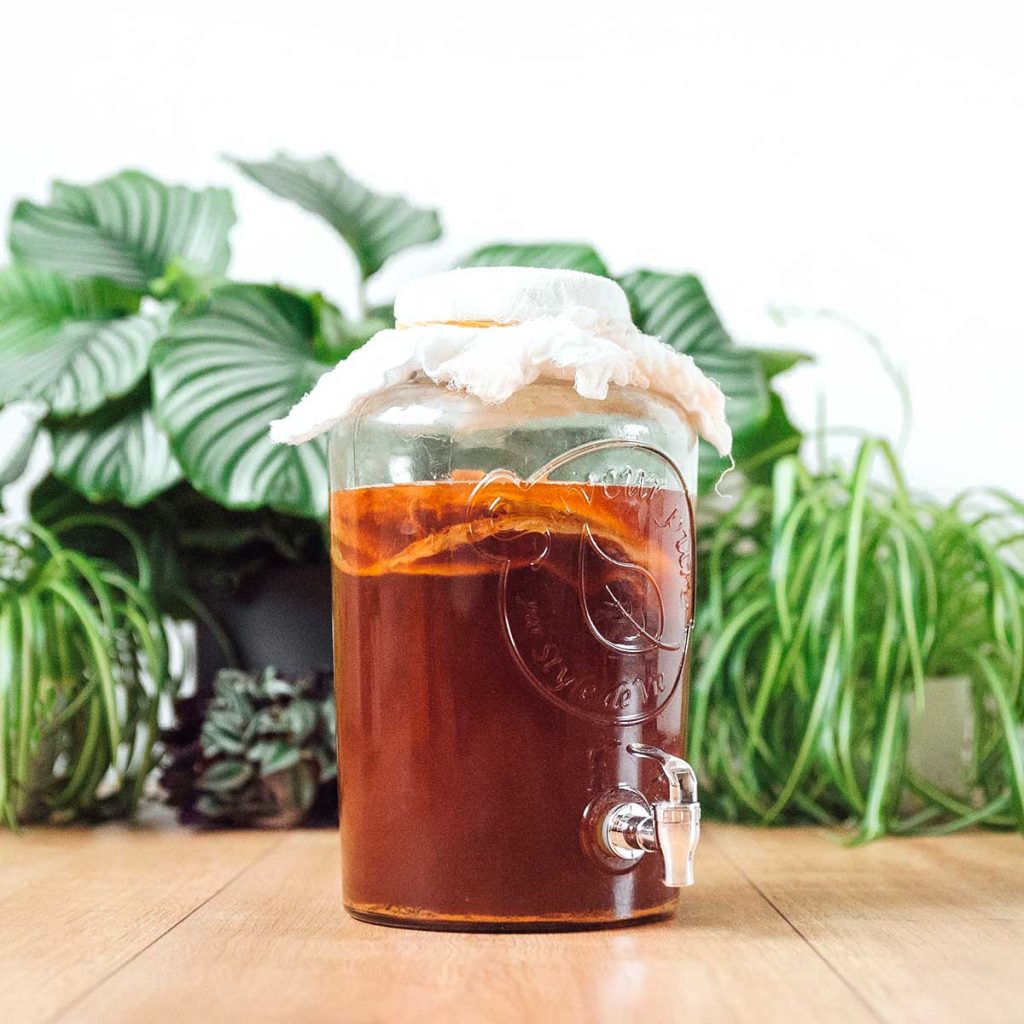

How To Make Hard Kombucha
Ingredients
- 1 cup hot water
- 1 cup white sugar
- 1 tsp champagne or ale yeast
- 1 gallon unflavored kombucha, from a first fermentation
Instructions
- Yeast Slurry: Stir together the hot water and sugar until sugar is dissolved. Let it cool to lukewarm, then stir in yeast. Allow the yeast to activate for 5 minutes, until bubbles form and the yeast is frothy.
- Bottle: Meanwhile, transfer kombucha to bottles or a growler (or any vessel with an opening that will fit your airlocks. Portion yeast slurry equally into each bottle of kombucha.
- Airlock: Fill airlocks with water (to the designated line – you may need to read the instructions for your particular airlocks). Place airlocks onto each bottle.
- Ferment: Set bottles somewhere dark and room temperature, and let ferment for 7 to 14 days. It’s ready when the flavor is somewhat dry and boozy! If you’re not moving on to the next step (adding flavor), seal the bottles shut and transfer to the fridge to stop the fermentation process.
- Flavor (optional): At this point you can flavor your bottles however you want! See our favorite kombucha flavors here.
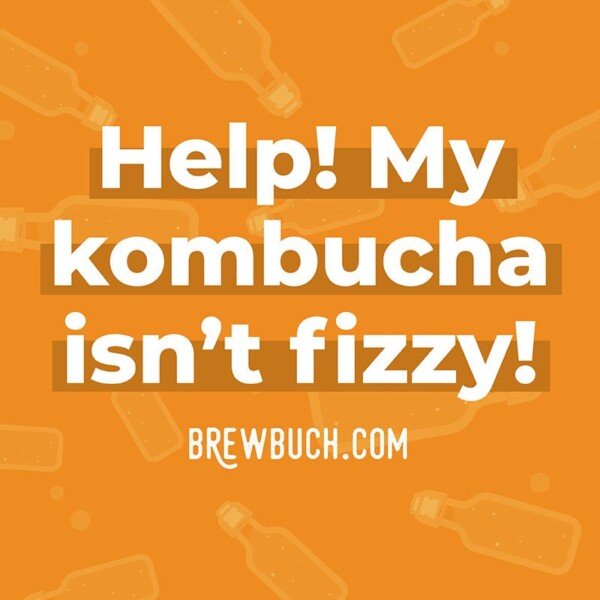
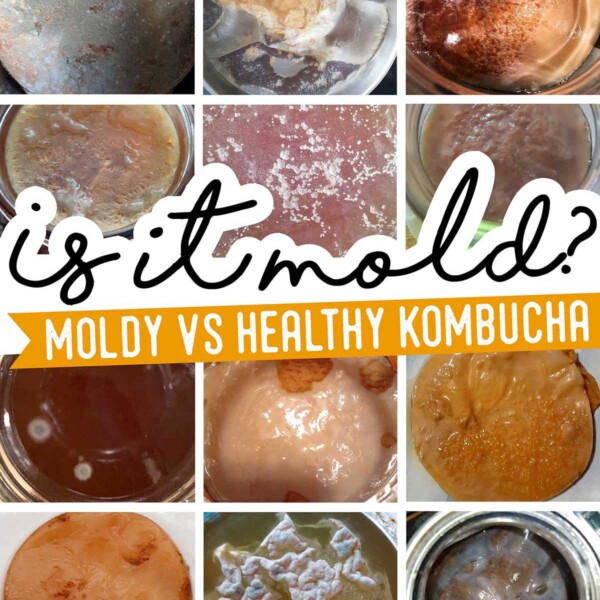

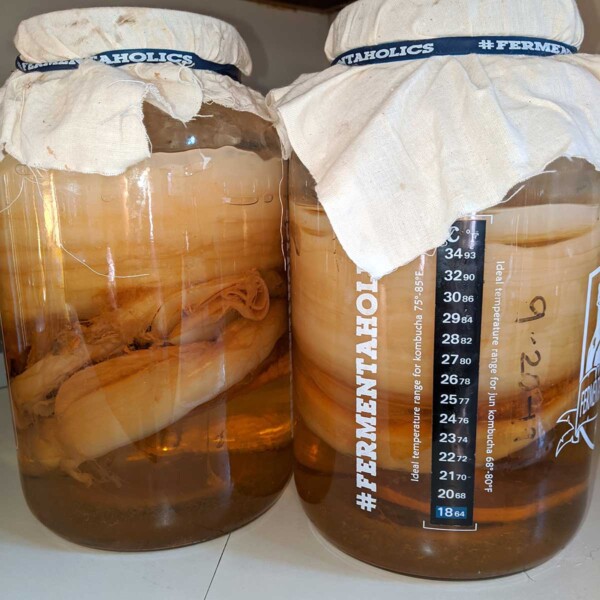
Thank you for this recipe! I am excited to start making hard kombucha. Just curious as to where you purchased swing top bottles to fit your airlocks. The bottles I ordered through your Amazon link do not fit the airlocks.
They fit on my IKEA bottles!
The first time I followed this recipe, I got a perfect boozy kombucha. The second time I followed this recipe, the kombucha didn’t get boozy at all. I didn’t do anything different. What could be the reason? The yeast was activated/hydrated beforehand.
Hi Anita! If everything seemed the same but the second batch didn’t get boozy, a few sneaky factors could be at play: temperature is a big one (cooler temps can stall yeast), or the sugar levels might’ve been slightly off. Even using a more acidic starter or stronger tea can slow yeast down. Also, if the yeast sat too long after activation or didn’t have enough time/space to thrive, that could affect results too. Hard booch can be finicky, so keep notes if you try again—you’re so close to cracking your perfect recipe!
Great Job! Easy to read and to understand! Great page design! Congratulations!
Thank you!!!
Thank for this! How would this process differ from just adding an alcohol like vodka to the kombucha after 1st or 2nd fermentation?
Getting back to you a bit late—thanks for your patience! Adding vodka after fermentation does raise the alcohol level, but it’s different from brewing hard kombucha. When you brew it, you’re feeding the yeast extra sugar (like juice or cane sugar) and letting it naturally ferment to a higher alcohol percentage, which gives a smoother, more integrated flavor. Vodka boosts the ABV quickly, but it can taste a bit harsher and won’t produce the same natural carbonation or depth of flavor. Both work—it just depends if you want fast results or that true “hard booch” experience!
Hi Sarah,
Definitely going to give this a try, mostly just for a fun thing to do! I’ve watched and read many posts on hard kombucha and people say it still retains all it’s goodness but now in the form of an alcoholic drink. BUT, i’ve also read that isn’t true, because once you do the second ferment and up the alcohol volume it kills any probiotics that were initially in the brew. To me that makes sense, we use alcohol wipes etc to kill bacteria. If you have some better insight into this, i’d really like to hear it. I’m still going to do it! Because like i said, for fun! But unclear if it’s really any good at all for you anymore regarding probiotics. Thank you in advance! 🙂
That’s actually a great question! My inkling is that while there is still some probiotic benefit, some of it will have been damaged by the high ABV. But I don’t know for sure, honestly!
Unsure if i did something wrong :/ my second ferment – with added ale yeast is about 10 days in and it still tastes sweet. The yeast i got is LalBrew VOSS Kveik Brewing Yeast – Kveik Ale Yeast. It’s supposed to work very fast, says within a few days at optimal temp which i’ve kept it at. Have i ruined this batch? Toss it, or add more yeast or continue to wait? Unsure where to go from here. Thank you Sarah.
Can you see bubbles forming or any frothing? That would be a sign that the yeast is alive and working.
no frothing, no bubbles … well damn!
Shoot! Could you have added the yeast while the mixture was too hot?
No, it was only warm not hot. Well maybe the yeast was no good. Back to the drawing board so to speak lol thank you for your time Sarah 🙂
Thanks for all the great info. For some reason I can follow the link to the FB group. Can you tell me the name so I can search it.
Thanks!!
Yes! It’s Kickass Kombucha Brewers 🙂
What ph do you suggest starting the hard brew?
You are perfect with room to grow!
Gratitude & Love
Mike
I typically go more by flavor than by pH! But a kombucha pH of 2.5 and 3.5 is normal 🙂
Hello, I’ve attempted this recipe a few times. I seem to be having a hard time with yeast slurry. I’m using EC-1118 and get water/sugar to lukewarm (about 110-115) and add yeast. Nothing seems to foam, no action or anything. Do i need to follow the instructions on the EC-1118 prior to this step then also complete this step? Any thoughts?
That’s strange, it should be foaming in those conditions. Could you try reducing the temp just a little (high 90s?) That makes me think you may have a dud batch of EC-1118.
Can you do second ferment for 20-30 days?
You can, but the flavor is going to continue to develop and it might turn into something less than tasty if you go for too long.
Making hard kombucha. On the second fermentation with yeast. Was going great. 6th day it stopped all fermenting. Initial ABV 1.023 now less than 1.000. What did I do wrong and can this batch be saved?
Oh strange! I haven’t heard of that happening before. You might drop this question in our kombucha facebook group!